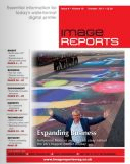Have you a slick workflow that harnesses the full potential of your kit line-up or is there room for manoeuvre?
“When customers first look at investment they tend to focus on the biggest capital expense and how they expect that to add to their bottom line,” states Paul Bates, EskoArtwork regional business manager UK and Eire. “But what they often don’t consider is the added pressure this puts on all their departments and the potential bottlenecks this could introduce into their workflow.



